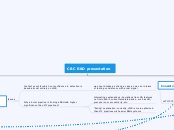CBC R&D presentation
Introduction: 3 slides
Basic description of what we have done
Method: we compare the cWB point estimate waveform for a given GW/LVT event with a distribution of its PE posterior samples injected on O2 data and reconstructed by cWB.
Confidence belts: Departure of the cWB point estimate (red curve) outside of the corresponding confidence belts
gives us a conservative measure of the statistical agreement between the burst waveform and the PE samples
LVT170729: summary of PE runs so far
Issues
the first event for which our confidence in detection is based almost entirely on cWB
we should make as strong a case as we can in terms of testing consistency with a real signal
Why a burst pipeline is finding a BBH with higher significance than MF pipelines?
Interesting explanations: deviations from GR, features not included in current template banks, such as HM, precession or eccentricity, etc.
"Boring" explanation: currently, cWB is more optimized than MF pipelines wrt heavier BBH systems
Consistency test: 2 slides
LVT170729: plot
Minor inconsistency in the merger
Extra pixel
Vetting LVT170729: 1 slide
~30% of LVT170729 LALInference PE samples when injected on chunk 19 are found by cWB with higher significance than the original event (i.e. IFAR=56 yrs)
SImilar results for PE samples from the IMRPhenomHM run
What about PyCBC and GstLAL? If a significant fraction of the PE samples are consistent with their significance estimate (IFAR~1 yr) then we will know that for events like LVT170729 the discrepancy in significance that we observe is to be expected.
Technicalities: 1 slide
PE runs
Code implementations
code versions
